Inflatable minimally invasive system for delivering and securing an annular implant
a minimally invasive, annular implant technology, applied in the field of delivery and securing annular implants, can solve the problems of structural annulus, inability to fully appreciate the exact amount of narrowing required for the desired effect, and interruption of normal physiologic flow, etc., to achieve the effect of assessing the physiologic effect, altering the position, size and shap
- Summary
- Abstract
- Description
- Claims
- Application Information
AI Technical Summary
Benefits of technology
Problems solved by technology
Method used
Image
Examples
Embodiment Construction
[0045]As required, detailed embodiments of the present invention are disclosed herein; however, it is to be understood that the disclosed embodiments are merely exemplary of the invention which may be embodied in various forms. Therefore, specific structural and functional details disclosed herein are not to be interpreted as limiting, but merely as a basis for the claims and as a representative basis for teaching one skilled in the art to variously employ the present invention in virtually any appropriately detailed structure.
[0046]An improved annular implant delivery device has been developed for use in delivering an annular implant to an annulus in a patient's body. The delivery device can be housed in an endoscopic sheath or trocar or other covering, which is inserted into a patient to deliver an annular implant to an annulus in a minimally invasive procedure. The delivery procedure can be performed endoscopically, percutaneously, or with an endoscope placed within a body cavity...
PUM
 Login to View More
Login to View More Abstract
Description
Claims
Application Information
 Login to View More
Login to View More - R&D
- Intellectual Property
- Life Sciences
- Materials
- Tech Scout
- Unparalleled Data Quality
- Higher Quality Content
- 60% Fewer Hallucinations
Browse by: Latest US Patents, China's latest patents, Technical Efficacy Thesaurus, Application Domain, Technology Topic, Popular Technical Reports.
© 2025 PatSnap. All rights reserved.Legal|Privacy policy|Modern Slavery Act Transparency Statement|Sitemap|About US| Contact US: help@patsnap.com



